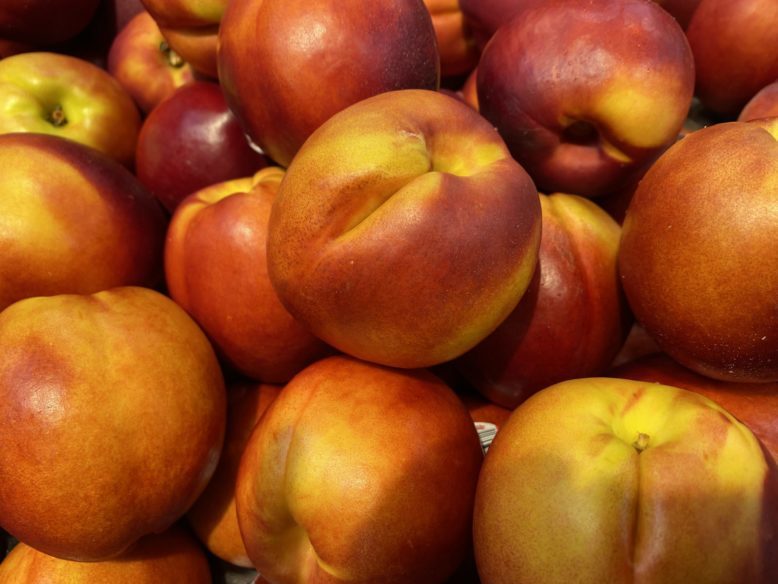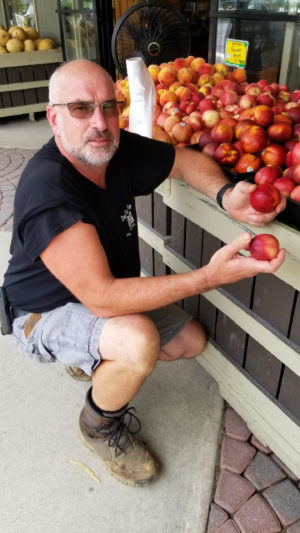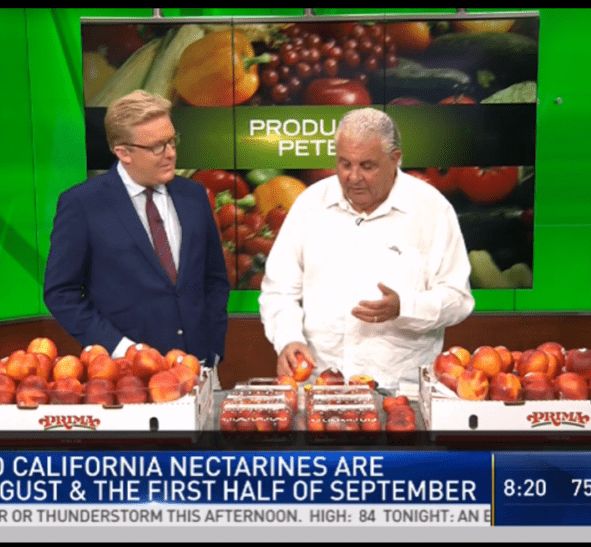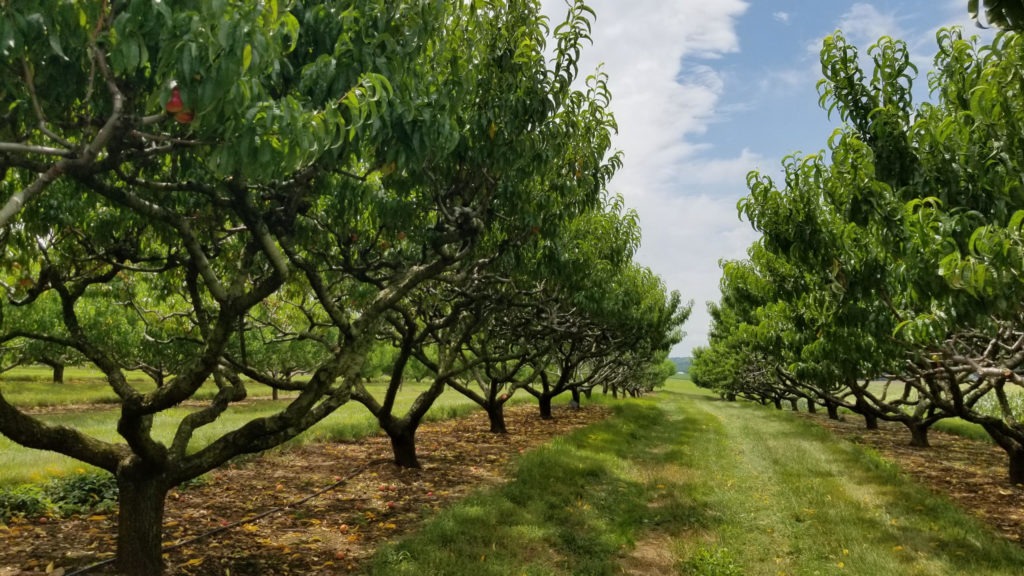
This year, California’s cold spring created some gaps in the production of nectarines, which led to supply shortages and subsequently higher nectarine prices in the very supply-and-demand-driven produce industry. The good news is that Jersey-grown nectarines are now in season from August through September, which should ensure that we’re back in full supply.
When I was a kid working at our family business, Napolitano’s Produce in Bergenfield, I remember running out to my father’s produce truck as he came back from the market and waiting for him to open the doors so I could experience the warm sweet smell from the nectarines. Although I love peaches, nectarines are a real treasure, and ripe nectarines have a taste that you never forget. When something is in season and especially when the season is coming to an end, I want to get my fill of it.
Though you’ll see nectarines most of the year, the ones now in season from California, New Jersey, New York and Pennsylvania are fresh, have been on the tree longer, and have reached full maturity, which ensures that they’re going to be good. So don’t let the summer go by without enjoying the special sweetness nectarines can deliver!
All About Nectarines
Until about 1940, nectarines were small, drab, green fruits that were also fragile and had a short shelf life, so they weren’t especially popular. In 1942, however, the LeGrand variety appeared, named after the town in California (Le Grand) where it originated. Since then, more than 100 different varieties have been developed and nectarines rank nearly equal to peaches as the most popular stone fruit. While many people think of nectarines as fuzzless peaches (and they are indeed related to other stone fruits like peaches, almonds and plums), nectarines are a little different. Among other things, nectarines are meatier and juicier than most peaches. They’re also more fragile because they’re not protected by a fuzzy skin. For that reason, most growers won’t ship a really ripe nectarine, so in most instances you’ll need to let nectarines ripen at home for a couple of days before eating.
Nutrition-wise, nectarines are worth the wait—they’re an excellent source of fiber, vitamins A and C and potassium, which helps reduce blood pressure and aids in regulating balance and muscle contractions.
Growing Nectarines

Farmer Greg Donaldson poses with a bin of freshly-picked nectarines at Donaldson Farms in Hackettstown. Photo courtesy of Donaldson Farms
Nectarines from Florida and Georgia begin to appear on the market in May, but they tend to be green and hard. By late July through September, however, California and local tree-ripened nectarines are really superb. Nectarines aren’t the easiest to cultivate, however, as Greg Donaldson, co-owner of Donaldson Farms—a 600-acre, family-owned farm in Hackettstown that’s been in business for over a century—can attest.
“Because they have no fuzz, which helps protect against disease, insects, and weather, nectarines are very vulnerable to environmental conditions and can be challenging to grow,” confirmed Donaldson, whose farm’s 100 nectarine trees produce a range of different yellow and white varieties. He noted that nectarine trees grow about 9 to 10 feet in height and can yield as many as 500 nectarines in a season, which typically runs from early August to mid-September. But because of variables like frost, excessive rain, and pests, “certain trees can have a far smaller yield and some of the nectarines that do mature can end up with what we call a “rough finish”—scars and indents—even though they taste delicious,” he said.
While the space devoted to growing nectarines at Donaldson Farms represents a small part of their total peach acreage, nectarines are an important bit of variety that the Donaldson family is proud to offer local consumers. “A lot of people, including myself, like nectarines because they don’t have fuzz, which can sometimes be tough on the palate,” he acknowledged. “Nectarines are nice and easy—you can eat them right off the tree and they’re a delicious and sweet symbol of summer.”
Selection and Storage
Look for colorful, unbruised fruit (though you may have to accept a bruise or two on really ripe nectarines). Avoid fruit that looks green or has a wrinkled or leathery-looking skin and choose medium-to-large nectarines, as gigantic ones will likely be mealy and very small ones were probably picked too green. Often your best bet will be to buy nectarines that are still firm; Take them home and let them ripen on the counter for a day or two until they have a little give and develop a wonderful fragrance. To accelerate the ripening process of nectarines (as well as peaches), simply place the firm fruit inside a paper bag (plastic bags won’t work and can cause off flavors in the fruit), loosely close the top, and keep it at room temperature for a day or two. As peaches and nectarines ripen, they give off a natural hormone called ethylene; the paper bag will trap the ethylene close to the fruit while still allowing for the exchange of air into and out of the bag.
You can refrigerate a nectarine when it’s fully ripe, but only for a day or two, as longer refrigeration will cause a type of damage called “internal breakdown” that will rob the fruit of its juice and flavor.
Preparation

Produce Pete shares top tips on nectarines with anchorman Gus Rosendale during a recent segment on NBC Weekend Today in New York. Photo courtesy of Pete Napolitano/NBC
Nectarines are excellent eaten out of hand, but there are other delicious ways to enjoy them too. Here are a few great ways that my wife, Bette, prepares them in our household:
—Create a “nectarine antipasto” by combining chilled, sliced fresh nectarines with sliced green onions, sliced fresh mushrooms, snipped fresh dill, salt, pepper, and an oil and vinegar dressing and serve in lettuce cups.
—For breakfast, stir together crisp rice cereal or corn flakes, honey, and flaked coconut. Spoon this mixture into ripe nectarine halves placed in a shallow pan, then heat them in the oven at a low temperature until the nectarines are warm and the coconut is lightly toasted.
—For a quick and tangy nectarine relish for hamburgers or fish, chop equal quantities of fresh nectarines and firm tomatoes, add a generous measure of chopped scallions, and stir in chopped fresh mint or basil.
—Enjoy nectarines in a chicken sandwich by shredding the chicken and adding alfalfa sprouts and thinly-sliced fresh nectarines moistened with well-seasoned mayonnaise or tart French dressing. Stuff into pita pockets.
Or, for a great summertime dessert, enjoy Bette’s nectarine cobbler, one of my favorites!
Bette’s Famous Nectarine Cobbler
(Serves 6)
Ingredients:
1 stick (4 ounces) butter, melted
1 cup plus 3 tablespoons granulated sugar, divided
1 cup all-purpose flour
2 teaspoons baking powder
¼ teaspoon salt
1 cup milk
1 teaspoon vanilla extract
3 to 4 ripe nectarines, peeled, pitted, thinly-sliced (yellow or white flesh nectarines)
½ teaspoon cinnamon
Instructions:
Preheat oven to 375 degrees. Pour melted butter into a 2-quart baking dish (11×7 or 8-inch square). In a mixing bowl, combine 1 cup of the sugar, the flour, baking powder, and salt and stir to blend. Stir in the milk and vanilla until blended and pour the batter over the melted butter. Toss the nectarines with the remaining 3 tablespoons of sugar and ½ teaspoon of cinnamon and arrange the nectarine slices over the batter. Bake for 25 to 30 minutes or until a toothpick inserted into the cake comes out clean; the top will be browned and the cake will begin to pull away from the sides of the pan. Serve warm with a little heavy cream, whipped topping, or a scoop of vanilla ice cream and enjoy!
About “Produce Pete” Napolitano
With over 65 years of experience in the produce industry, New Jersey’s own “Produce Pete” Napolitano is a renowned fruit and vegetable expert, author, and television personality who’s appeared on a highly-popular segment on NBC’s Weekend Today in New York broadcast every Saturday mornings for over 27 years. For more information, visit Pete’s website.
About Susan Bloom
A contributor to New Jersey Monthly and a variety of other well-known local and national publications, Susan Bloom is an award-winning New Jersey-based freelance writer who covers topics ranging from health and lifestyle to business, food and more. She’s collaborated with Produce Pete on a broad range of articles for nearly a decade.


